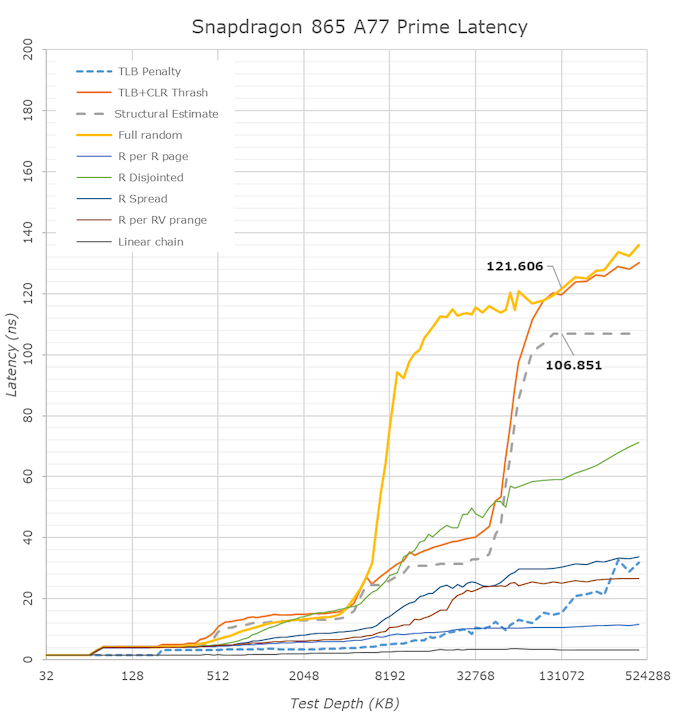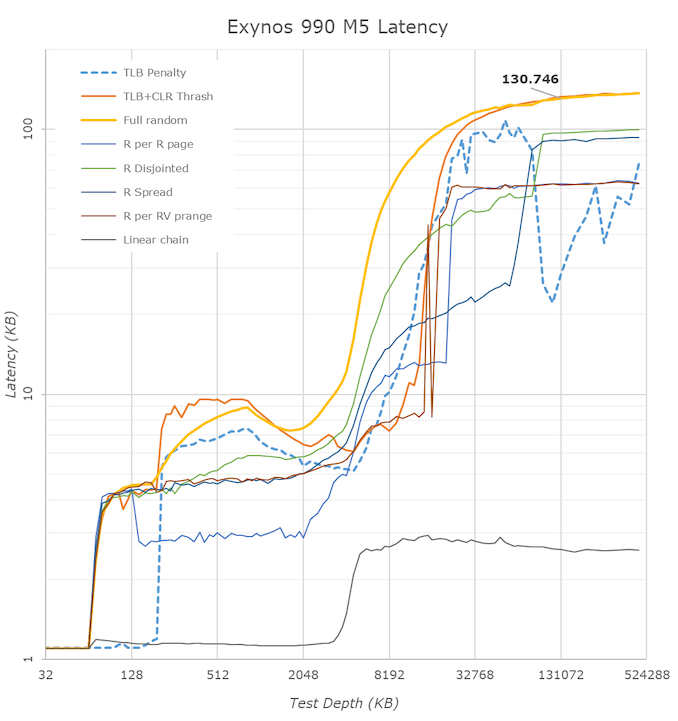The Samsung Galaxy S20+, S20 Ultra Exynos & Snapdragon Review: Megalomania Devices
by Andrei Frumusanu on April 3, 2020 9:30 AM ESTMemory Subsystems Compared
On the memory subsystem side, there’s quite a few big changes for both the Snapdragon 865 as well as the Exynos 990, as these are the first commercial SoCs on the market using LPDDR5. Qualcomm especially is said to have made huge progress in its memory subsystem, and we’re now able to verify the initially promissing results we saw on the QRD865 back in December with a production device.
And indeed, the news keeps on getting better for Qualcomm, as the new Galaxy S20 showcases even better memory results than we had measured on the reference device. The improvements over the Snapdragon 855 are just enormous and Qualcomm not only manages to catch up but very much now is able to beat the Exynos chips in terms of memory subsystem performance.
Arm very famously quotes that an improvement of 5ns in memory latency corresponds to an increase of around 1% in performance. And if that’s the case, Qualcomm will have had a ~12% improvement in CPU performance just by virtue of the new memory controller and SoC memory subsystem design. Our structural estimate in the memory latency falls in around 106 vs 124ns – most of the improvement seems to be due to how Qualcomm is now handling accesses to the DRAM chips themselves, previously attributing the bad latencies on the Snapdragon 855 due to power management mechanisms.
Samsung’s Exynos 990 also improves in memory latency compared to the Exynos 9820, but by a smaller margin than what the Snapdragon 865 was able to achieve. All latency patterns here are still clearly worse than the Qualcomm chip, and there’s some oddities in the results. Let’s zoom in into a logarithmic graph:
Comparing the Exynos 990 results vs the Exynos 9820, it’s now quite visible that the L2 cache has increased dramatically in size, similar to what we’ve described on the previous page, corresponding to the doubling of the available cache to a core from 1MB to 2MB. Samsung’s cores still have some advantages, for example they’re still on a 3-cycle L1 latency design whereas the Arm cores make due with 4-cycle accesses, however in other regards, the design just falls apart.
The TLB issues that we had described last year in the M4 are still very much present in the M5 core, which results in some absurd results such as random accesses over a 2MB region being actually faster than at 1MB. Cache-line accesses with TLB miss penalties now actually have lower access latencies in the L3 than in the L2 regions, and I have no idea what’s happening in the 16-64MB region in that test as it behaves worse than the 9820.
Examining the A76 cores of the Exynos 990, we see a much cleaner set of results more akin to what you’d expect to see from a CPU. Here we also see the 2MB SLC cache hierarchy in the 1-3MB region, meaning the Arm core cluster does have access to this cache, with the M5 cores bypassing it for better latency. Last year I had noted that the A76’s prefetchers had seen some massive improvements, and this is again evident here in the result sets of the two CPUs on the same chip as the middle cores actually handle some access patterns better than the M5 cores.
Samsung has had large issues with its memory subsystem ever since the M3 design, and unfortunately it seems they never addressed them, even with the more recent M5 core.
The Snapdragon 865 here is quite straightforward. The biggest difference to the 855, besides the improved DRAM latency, is the doubling of the L3 from 2 to 4MB which is also immediately visible. It still pales in comparison to the Apple A13’s cache hierarchy, but we do hope that the Arm vendors will be able to catch up in the next few years.













137 Comments
View All Comments
katakuri4744 - Wednesday, April 8, 2020 - link
Hi Andrei,Appreciate such a detailed article. I have one question, how did you pull the voltage curve, is there a command?
I had S10 exynos then upgraded it to S20+ exynos, both the articles had this voltage curve though the Snapdragon variant does not, I would like to check the same for my device as well.
helloworld_chip - Monday, April 6, 2020 - link
Though 865's compute efficiency loks pretty good, from some other data points I heard that its infrastructure power (impacting real user-daily activities, light-loaded scenarios) is quite BAD. Would be good if more such comparisons are available to confirm this, since it determines how long people can actually use a phone.s.yu - Monday, April 6, 2020 - link
Idle is relatively inefficient and the numbers here show.helloworld_chip - Monday, April 6, 2020 - link
Gotcha thx.I am thinking we should calculate bat-capacity / hours instead of just hours to really show how is the SoCs overall efficiency.
Bigger and Bigger battery really make us feel heavier, we should push the designer harder to make these more efficiency instead of just using larger and larger battery.
FunBunny2 - Tuesday, April 7, 2020 - link
"Bigger and Bigger battery really make us feel heavier, we should push the designer harder to make these more efficiency instead of just using larger and larger battery. "last time I looked, most of the battery goes to driving the screen. so resurrect your original iPhone. the notion that batteries will have increasing power density this millennium is fantasy. Li is the smallest source of electrons available. well, unless you're willing to carry around a Hindenburg in your pocket.
s.yu - Tuesday, April 7, 2020 - link
Technically I'm with you but I just don't trust all developers to sufficiently optimize their code. You see that Peachncream guy who always claims that his dinosaur fossils run everything smoothly but it just doesn't happen to me. The way it is my S6E(backup device) that literally runs 3 apps in all(not even simultaneously, AFAIK) with animations turned off in dev mode is much slower than his...some really old low end phone, same thing with the battery, a large capacity gives me peace of mind over any optimization because I know that nothing could eat through the battery too fast.watzupken - Monday, April 6, 2020 - link
This is the reason why I will not consider any Samsung Galaxy phone that is running on Exynos SOC. If it is on the low/ mid end, I can't complain about it. But when shelling out for a flagship, I don't see why one would pay the same amount for the slower variant and you don't have the choice to get the superior version locally.andyfrut - Monday, April 6, 2020 - link
Is the S20+ (855) comparable with the S20 Ultra (855) in battery life in 120hz?andyfrut - Monday, April 6, 2020 - link
snapdragon 865*Ayaan_G - Tuesday, April 7, 2020 - link
The 5G addition to the Samsung Galaxy series will really give it a boost in another level !